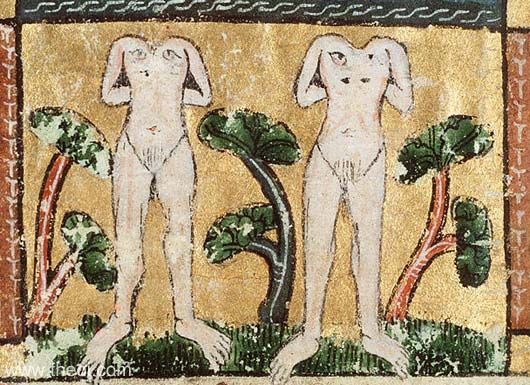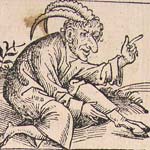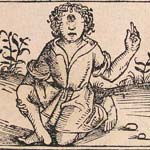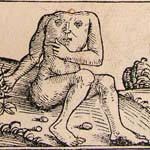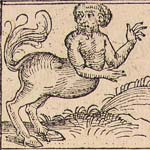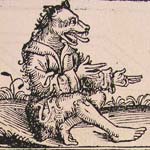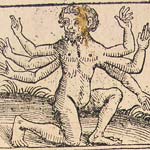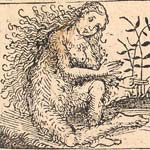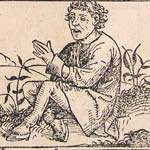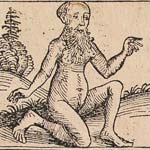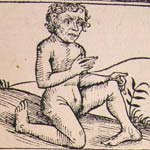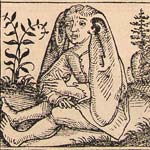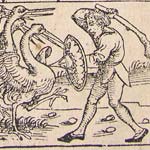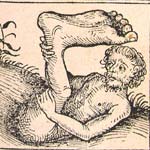LEGENDARY TRIBES
Ancient Greek and Roman writers filled the unexplored reaches of the world with fabulous and bizarre tribes of men. The most famous catalogue of these is found in Pliny's Natural History, a book which inspired medieval bestiaries and the illustrators of old maps. The following collection of images is from the Nurenberg Chronicle of 1493.
A COMPLETE LIST OF THE FANTASTIC TRIBES OF ANCIENT GREEK LEGEND
ABARIMONES A tribe of backward footed men who lived somewhere in the Himalayas.
AEGIPANES A tribe of goat-legged and horned men who lived in the Atlas Mountains of Libya.
AMAZONS A tribe of warrior women. They fought with Heracles, Theseus and the Greeks during the Trojan War.
ANDROPHAGI (Androphagoi) A tribe of African cannibals who lived entirely on the flesh of men.
ARIMASPIANS (Arimaspoi, Monommatoi) A tribe of one-eyed Scythian men who warred with the Griffins for gold.
ARIMPHAEI (Arimphaioi) A sacred Scythian tribe, blessed like their neighbours the Hyperboreans.
ARTABATITAE (Artabatitai) A tribe of African men who travelled around on all fours like apes.
ASTOMI (Astomoi) A hair-covered and mouthless Indian tribe who lived off the scent of aromatic plants.
ATLANTEANS (Atlantes) The people of the mythical island of Atlantis.
BLEMMYAE (Blemmyai, Sternophthalmoi) A tribe of headless African men whose faces were set upon their chests.
CALINGI (Kalingoi) A tribe of short-lived Indian men who reached maturity at the age of five and died aged eight.
CHOROMANDAE (Khromandai) A tribe of Indian men with hair-covered bodies, dog's teeth and a horrible scream in place of speech. They were basically a type of ape.
CYCLOPES (Kyklopes) A tribe of barbarous, one-eyed giants who shepherded their flocks on the island of Sicily.
CYNOCEPHALI (Kunokephaloi, Hemikunes) A tribe of dog-headed African men. They were probably baboons.
GEGENEES A tribe of six-armed, earth-born men fought by the Argonauts on Bear Mountain in Mysia.
GORGADES An African tribe whose womenfolk were covered in long hair.
HELIADES A fabulous people who inhabited seven happy islands in the southern ocean. They were almost hairless with bendable bones and a double-tongue which allowed them to hold two conversations at the same time.
HIPPOPODES A tribe of northern European men with horses' feet.
HYPERBOREANS (Hyperboreioi) A fantastic race of long-lived men who lived in a land of eternal spring beyond the north wind.
LAESTRYGONES (Laistrygones) A tribe of cannibal giants native to Italy or northern Europe. They were encountered by Odysseus on his travels.
MACHLYES (Makhlyes) A Libyan tribe of androgynes whose bodies were female on one side and male on the other.
MACROBI (Makroboi) A tribe of long-lived Indian men who were never touched by signs of old age.
MACROCEPHALI (Makrokephaloi) An African tribe of men with long, elongated heads.
MANDI (Mandoi) A race of Indians who grew old and wrinkled shortly after birth.
MELANOCHROTI (Melanokhrotoi) A tribe of black-skinned men ruled by a king with a single eye in the middle of his forehead.
NULI (Nuloi) An African people with backward-turned, eight-toed feet.
PANDAE (Pandai) A tribe of long-lived Indian men with gigantic ears, eight fingers and toes, and hair covered bodies. The hair was white with youth but changed to black as they aged.
PANOTII (Panotioi) A fabulous northern European tribe with gigantic, body-length ears.
PYGMIES (Pygmaioi) A tribe of diminutive African men just one pygme tall (a pygme being the length from elbow to knuckle on a regular man). They were engaged in an endless war with migrating flocks of cranes.
SCIAPODS (Skiapodes, Steganopodes) A tribe of one-legged, one-footed Libyan men. The Sciapod sheltered himself from the sun beneath a giant, upraised foot. For this reason they were known as Umbrella- or Shadow-Foots.
SCIRITAE (Sikiritai) An Indian tribe with snake-like nostrils in place of the nose, and bandy serpentine legs.
STRUTHOPODES (Strouthopodes) An Indian tribe whose womenfolk had tiny, sparrow-like feet, but whose men grew giant 18 inch long ones.
SYRBOTAE (Syrbotai) A tribe of twelve-foot tall African men.
ON FANTASTIC TRIBES - EXTRACTS FROM PLINY'S NATURAL HISTORY
The following extracts from Pliny's Natural History describe various fabulous tribes believed to inhabit the distant corners of Europe, India and Africa.
Pliny the Elder, Natural History 4. 88-94 (trans. Rackham) :
"Along the coast [of the Black Sea], as far as the river Tanais [the Don], are the Maeotae [tribe of Scythians] . . . and last of all in the rear of the Maeotae are the Arimaspi. Then come the Ripaean Mountains [possibly the Carpathians] and the region called Peterophorus, because of the feather-like snow continually falling there; it is a part of the world that lies under the condemnation of nature and is plunged in dense darkness, and occupied only by the work of frost and the chilly lurking-places ofthe North Wind. Behind these mountains and beyond Aquilo there dwells (if we can believe it) a happy race of people called the Hyperboreans, who live to extreme old age and are famous for legendary marvels. Here are believed to be the hinges on which the firmament turns and the extreme revolutions of the stars, with six months' daylight and a single day of the sun in retirement, not as the ignorant have said, from the spring equinox till autumn: for these people the sun rises once in the year, at midsummer, and sets once, at midwinter. It is a genial region, with a delightful climate and exempt from every harmful blast. The homes of the natives are the woods and groves; they worship the gods severally and in congregations; all discord and all sorrow is unknown. Death comes to them only when, owing to the satiety of life, after holding a banquet and anointing their old age with luxury, they leap from a certain rock into the sea: this mode of burial is the most blissful. Some authorities have placed these people not in Europe but on the nearest part of the coasts of Asia, because there is a race there with similar customs and a similar location, named the Attaci; others have put them midway between the two suns, the sunsets of the antipodes and our sunrise, but this is quite impossible because of the enormous expanse of sea that comes between. Those who locate them merely in a region having six months of daylight have recorded that they sow in the morning periods, reap at midday, pluck the fruit from the trees at sunset, and retire into caves for the night. Nor is it possible to doubt about this race, as so may authorities state that they regularly send the first fruits of their harvests to Delos as offerings to Apollo, whom they specially worship. These offerings used to be brought by virgins, who for many years were held in veneration and hospitably entertained by the nations on the route, until because of a violation of good faith they instituted the custom of depositing their offerings at the nearest frontiers of the neighbouring people, and these of passing them on to their neighbours, and so till they finally reached Delos. Later this practice itself also passed out of use.
"Crossing the Ripaean Mountains must coast to the left along the shore of the northern ocean until we reach Gadis. In this direction a number of islands are reported to exist [possibly in the Baltic Sea] . . . the Hippopodes on which people are born with horses' feet, which gives them their Greek name; there are others called the Panotiorum (All-Ears Islands) in which the natives have very large ears covering the whole of their bodies, which are otherwise left naked."
Pliny the Elder, Natural History 7. 9-11 (trans. Rackham) :
"Some Scythian tribes, and in fact a good many, feed on human bodies--a statement that perhaps may seem incredible if we do not reflect that races of this portentous character have existed in the central region of the world, named Cyclopes and Laestrygones . . . According to Isogonus of Nicaea the former cannibal tribes whom we stated to exist to the north, ten days' journey beyond the river Borysthenes [Dnieper], drink out of human skulls and use the scalps with the hair on as napkins hung round their necks. Also a tribe is reported next to these, towards the North, not far from the actual quarter where the North Wind rises and the cave that bears its name, the place called the Earth's Door-Bolt--the Arimaspi whom we have spoke of already, people remarkable for having one yes in the centre of their forehead. Many authorities, the most distinguished being Herodotus and Aristeas of Proconnesus, write that these people wage continual war with the Grypes (Griffins), a kind of wild beast with wings, as commonly reported, that digs gold out of mines, which the creatures guard and the Arimaspi try to take from them, both with remarkable covetousness.
"Beyond the other Scythian cannibals, in a certain large valley in the Imani Mountains [the Himalayas], there is a region called Abarimon where are some people dwelling in forests who have their feet turned backward behind their legs, who run extremely fast and ranges abroad over the country with the wild animals. It is stated by Baeton, Alexander the Great's route-surveyor on his journeys, that these men are unable to breathe in another climate, and that consequently none of them could be brought to the neighbouring kings or had ever been brought to Alexander."
Pliny the Elder, Natural History 7. 21-31 (trans. Rackham) :
"India and parts of Aethiopia especially teem with marvels. The biggest animals grow in India: for instance Indian gods are bigger than any others. Indeed the trees are said to be so lofty that it is not possible to shoot an arrow over them, and the richness of the soil, temperate climate and abundance of springs bring it about that, if one is willing to believe it, squadrons of cavalry are able to shelter beneath a single fig-tree; while it is said that reeds are of such a height that sometimes a single section between two knots will make a canoe that will carry three people. It is known that many of the inhabitants are more than seven feet six inches high, never spit, do not suffer from headache or toothache or pain the eyes, and very rarely have pain in any other part of the body--so hardy are they made by the temperate heat of the sun; and that the sages of their race, whom they call Gymnosophists, stay standing from sunrise to sunset, gazing at the sun with eyes unmoving, and continue all day long standing first on one foot and then on the other in the glowing sand.
"Megasthenes states that on the mountain named Nulus there are people with their feet turned backwards and with eight toes on each foot, while on many mountains there is a tribe of human beings with dogs' heads, who wear a covering of wild beasts skins, whose speech is a bark and who live on the produce of hunting and fowling, for which they sue their nails as weapons; he says that they numbered more than 120,000 when he published his work.
"Ctesias writes that also among a certain race of India the women bear children only once in their life time, and that the children begin to turn grey directly after birth; he also describes a tribe of men called Monocoli who have only one leg, and who move in jumps with surprising speed; the same are called Sciapodes (Shadow-Foots) tribe, because in the hotter weather they lie on their backs on the ground and protect themselves with the shadow of their feet; and that they are not far away from the Troglodyti (Cave-Dwellers); and again westward from these there are some people without necks, having eyes in their shoulders. There are also Satyri in the mountain in the east of India (it is called the district of Catarcludi); this is an extremely swift animal, sometimes going on all fours and sometimes standing upright as they run, like human beings; because of their speed only the old ones or the sick are caught. Tauron gives the names of Chromandae to a forest tribe that has no speech but a horrible scream, hairy bodies, keen grey eyes and the teeth of a dog.
"Eudoxus says that in the south of India men have feet eighteen inches long and the women such small feet that they are called Struthopodes (Sparrow-feet). Megasthenes tells of a race among the Nomads of India that has only holes in the place of nostrils, like snakes, and bandy-legged; they are called the Sciritae. At the extreme boundary of India to the East, near the source of the Ganges, he puts the Astomi tribe, that has no mouth and a body hairy all over; they dress in cottonwool and live only on the air they breath and the scent they inhale through their nostrils; they have no food or drink except the different odours of the roots and flowers and wild apples, which they carry with them on their longer journeys so as not to lack a supply of scent; he says they can easily be killed by a rather stronger odour than usual.
"Beyond these in the most outlying mountain region we are told of the Three-Span (Trispithami) Pygmae who do not exceed three spans, that is, twenty-seven inches, in height; the climate is healthy and always spring-like, as it is protected on the north by a range of mountains; this tribe Homer has also recorded as being beset by cranes. It is reported that in springtime their entire band, mounted on the backs of rams and she-goats and armed with arrows, goes in a body down to the sea and eats the cranes' eggs and chickens, and that this outing occupies three months; and that otherwise they could not protect themselves against the flocks of cranes would grow up; and that their houses are made of mud and feathers and egg-shells. Aristotle says that the Pygmae live in caves, but in the rest of this statement about them he agrees with the other authorities.
"The Indian race of Cyrni according to Isigonus live to 140; and the holds that the same is true of the long-lived Aethiopes, the Seres (Chinese) and the inhabitants of Mount Athos--in the last case because their diet of snakes' flesh, which causes their head and clotehs to be free from creatures harmful to the body. Onesicritus says that in the parts of India where there are no shadows there are men five cubits and two spans height [about 8 feet], and people live a hundred and thirty years, and do not grow old but die middle-aged.
"Crates of Pergamenus tells of Indians who exceed a hundred years, whom he calls Gymnetae, though many call them Macrobi (Long-Livers). Ctesias says that a tribe among them called the Pandae, dwelling in the mountain valleys, live two hundred years, and have white hair in their youth that grows back in old age; whereas others do not exceed forty years, this tribe adjoining the Macrobi, whose women bear children only once. Agatharchides records this as well, and also that they live on locusts, and are very swift-footed. Clitarchus gave them the name of Mandi; and Megasthenes also assigns them three hundred village, and says that the women bear children at age of seven and old age comes at forty.
"Duris says that some Indians have union with wild animals and the offspring is of mixed race and half animal; that among the Calingi, a tribe of he same part of India, women conceive at the age of five and do not live more than eight years, and that in another part men are born with a hairy tail and extremely swift, while others are entirely covered by their ears.
"Crates of Peramenus says that the Trogodytae (Cave-men) beyond Aethiopia are swifter than horses; also that there are Aethiopes more than twelve feet in height, and that this race is called the Syrbotae. The tribe of Aethiopes nomads along the river Astragus towards the north called the Menismini is twenty days journey from Oceanus; it lives on the milk of the animals that we call dog-headed apes (cynocephali), herds of which it keeps in pastures, killing the males except for the purpose of breeding. In the deserts of Africa ghosts of men suddenly meet the traveller and vanish in a moment."
MYTHOLOGY IN POST-CLASSICAL ART
One-legged Sciapods from the C14th illuminated manuscript Der Naturen Bloeme in the National Library of the Netherlands.
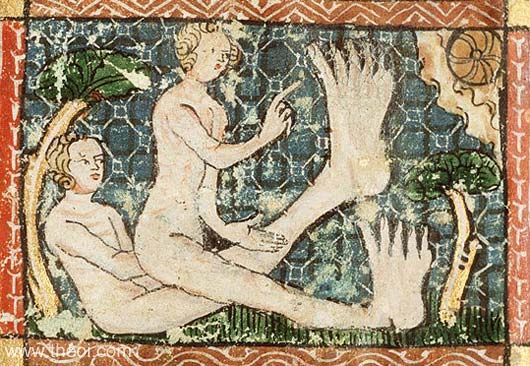
Headless Blemmyae from the C14th illuminated manuscript Der Naturen Bloeme in the National Library of the Netherlands.
